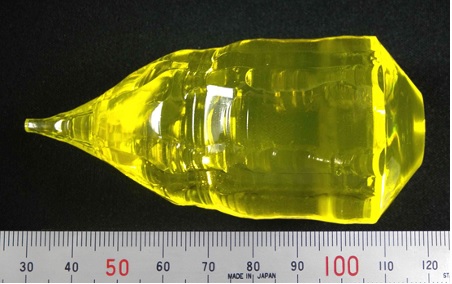Single-Crystal Phosphors Suitable for Ultra-Bright, High-Power White Light Sources

YAG single-crystal phosphor ingot. Image copyright: NIMS
The Optical Single Crystals Group at National Institute for Materials Science (NIMS) led by Group Leader Kiyoshi Shimamura and Senior Researcher E. Garcia Villora, in collaboration with Tamura Corporation (President, Naoki Tamura) and Koha Co., Ltd. (President, Yasuhiro Nakashima), successfully developed single-crystal phosphors (based on (Y1-xLux)3Al5O12 oxide-garnets) that use a blue LD (laser diode) as an excitation light source, are suitable for ultra-bright, high-power white lighting, and have outstanding temperature characteristics.
In line with environmentally conscious efforts to promote power-saving and mercury-free products, white lighting that uses blue LEDs as an excitation light source has grown rapid in popularity in recent years. At the same time, products that use blue LDs as an excitation light source have also been commercialized to meet the needs of certain light-p rojectors and car headlights.
These require a high-brightness that is difficult to attain with LED light sources. Due to its optical properties, LD light can be easily collected with a lens or mirror, and it is feasible to focus 100-watt-equivalent LD light on an area as small as several millimeters in diameter.
However, as the power density of the LD excitation light increases, the heat generated by the lighting device also increases proportionally. The use of conventional phosphors, with low thermal conductivities and a decreasing internal quantum efficiency with the temperature, requires complex cooling techniques and critically limits the applicable LD power. Further, non-oxide based powder phosphors degrade irreversibly with the temperature.
In this study, the developed single-crystal phosphors, grown from the melt by the Czochralski technique, exhibit superior temperature characteristics, overcoming mentioned difficulties. On the one hand, due to the higher thermal conductivity (over two orders of magnitude) they can be cooled much more efficiently, avoiding overheating and enabling downsizing and cost reduction of lighting products.
On the other hand, their quantum efficiency does not drop with the temperature, exhibiting an efficiency over 0.9 till 300 °C in either plate or powder form. These two features, high thermal conductivity and quantum efficiency, are so remarkable that when the emission of conventional phosphors is already quenched by the temperature rise, under the same nominal conditions the temperature of single-crystal phosphors barely increases. Thus, in contrast with conventional powder phosphors, single-crystal phosphors will allow the fabrication of brighter and more powerful lighting products.
Based on this study, we have already acquired two patents in Japan, and have applied for five additional patents in Japan and abroad. We are aiming at stablishing the growth methods for the efficient mass production of single-crystal phosphors for laser lighting products such as laser projectors and laser headlights by the end of FY2015 in collaboration with Tamura Corporation.
Associated links
Original press release from NIMS
Media Contact
More Information:
http://www.researchsea.comAll latest news from the category: Materials Sciences
Materials management deals with the research, development, manufacturing and processing of raw and industrial materials. Key aspects here are biological and medical issues, which play an increasingly important role in this field.
innovations-report offers in-depth articles related to the development and application of materials and the structure and properties of new materials.
Newest articles

A ‘language’ for ML models to predict nanopore properties
A large number of 2D materials like graphene can have nanopores – small holes formed by missing atoms through which foreign substances can pass. The properties of these nanopores dictate many…

Clinically validated, wearable ultrasound patch
… for continuous blood pressure monitoring. A team of researchers at the University of California San Diego has developed a new and improved wearable ultrasound patch for continuous and noninvasive…

A new puzzle piece for string theory research
Dr. Ksenia Fedosova from the Cluster of Excellence Mathematics Münster, along with an international research team, has proven a conjecture in string theory that physicists had proposed regarding certain equations….



